The 16 bridges you simply have to cross in Italy
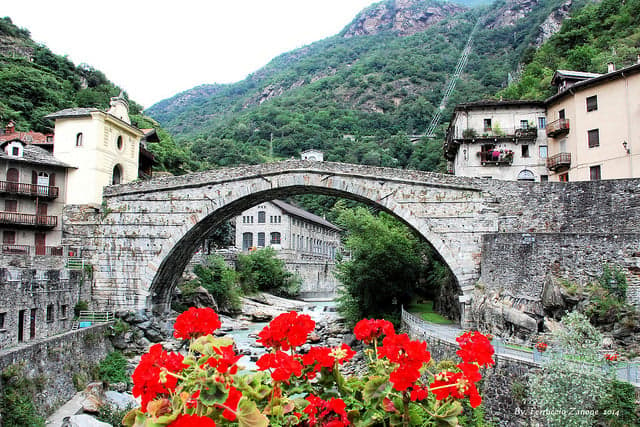
Did you know that Italy is home to the world's longest Tibetan bridge, or the reason why Ponte Vecchio survived the Second World War? Whether you prefer to visit places with a curious history or simply somewhere pretty to Instagram, there's something for you on our list of the 16 Italian bridges you should try to cross at least once in your life.
Ponte Castelvecchio, Verona
Let's start our tour of the most beautiful Italian bridges in fair Verona, where you'll find this spectacular medieval creation. It was built by Cangrande della Scala - a 14th-century nobleman and friend of Dante - as a potential escape route when Italy was split into rival regions.
The original bridge was totally destroyed by German troops in 1945, but it has been faithfully rebuilt. Look closely and you'll see that the bridge slopes downwards towards the river's left bank, aiding a fast get-away.
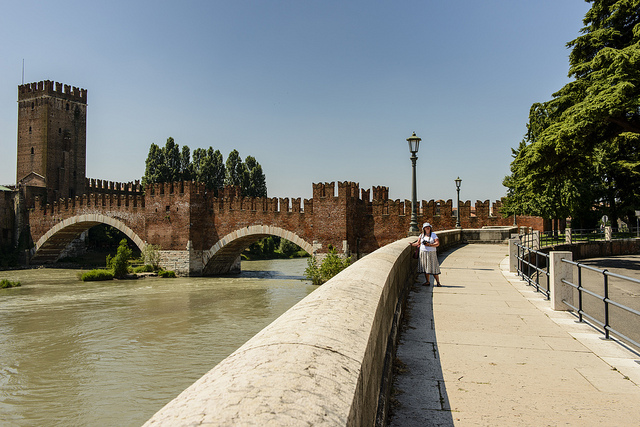 Photo: Son of Groucho/Flickr
Photo: Son of Groucho/Flickr
Ponte Sant'Angelo, Rome
Roman emperor Hadrian had this bridge built in 134 AD, linking the city centre to Castel Sant'Angelo, which now houses a museum. It's entirely pedestrianized so you can take your time strolling over it and take a close look at the statues of angels. Each of them symbolizes a part of Jesus's life and persecution.
But this bridge has a grisly past: hundreds of years ago, when the castle was a prison, bodies of executed criminals were displayed on it as a warning to Romans.
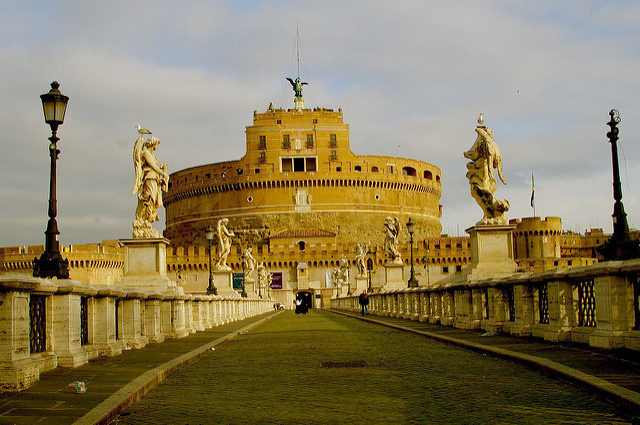 Photo: teldridge+keldridge/Flickr
Photo: teldridge+keldridge/Flickr
Ponte Matteotti, Rome
Taking its current name from socialist politician Giacomo Matteotti, who was kidnapped nearby, this brickwork bridge was constructed in 1929.
It's gone through a series of identities, starting life as Ponte delle Milizie and then becoming Ponte Littorio, named after the symbol of Italian Fascism. After the fall of Benito Mussolini's regime, it was one of many landmarks to get a name-change. Use the bridge to cross from Rome's fancy Prati district to Flaminio.
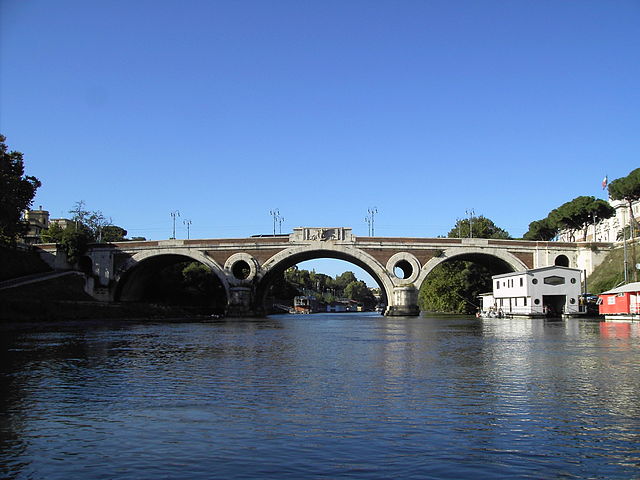 Photo: Lalupa/Wikimedia Commons
Photo: Lalupa/Wikimedia Commons
Ponte Fabricio, Rome
Spanning half of the Tiber River, this is Rome's oldest bridge still to exist in its original state, dating back to 62 BC. Astonishingly, it has remained in consistent use, so you can walk all 62 metres of it today.
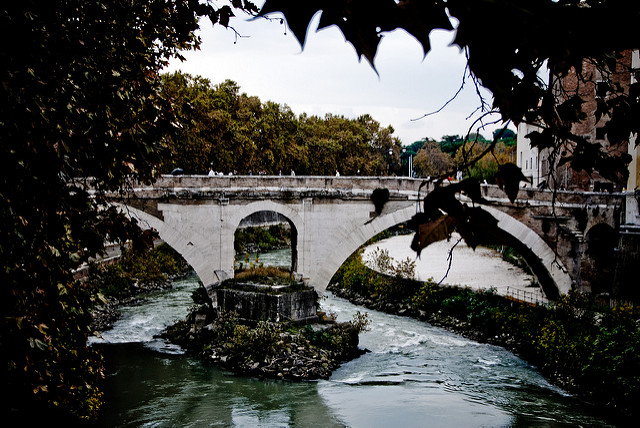 Photo: Ann Baekken/Flickr
Photo: Ann Baekken/Flickr
Ponte della Costituzione, Venice
Of course it wouldn't be an article about bridges without several mentions of Italy's canal-lined city, starting with this modern construction which has been in place less than a decade. It's also known as the Calatrava bridge, a nod to its designer Sergio Calatrava, but it's become pretty controversial.
Some complained that the Grand Canal didn't need a fourth bridge, while others felt that the minimalist style didn't match with the rest of the city. Then there were practical concerns, such as lack of wheelchair access.
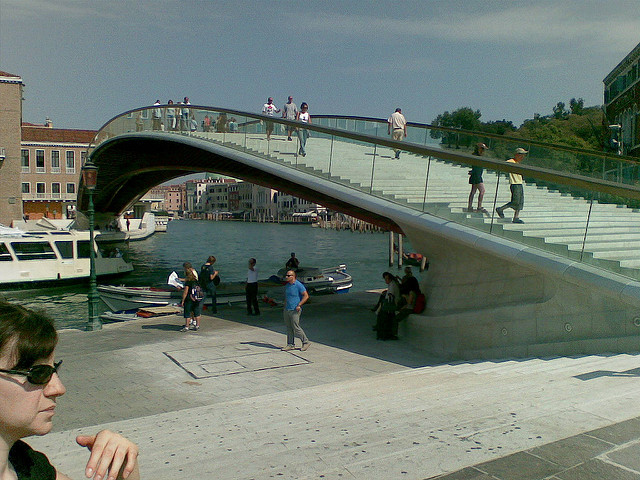 Photo: Michelino Calenda/Flickr
Photo: Michelino Calenda/Flickr
Ponte Gobbo, Piacenza
Literally translating as 'the Hunchbacked Bridge', this landmark is also known as Ponte Vecchio or Ponte del Diavolo, the Devil's Bridge. 273 metres long, it gets its official name from the 11 irregular arches that make it up.
But what's the devil got to do with it? Well, in the Middle Ages, building a bridge was a difficult task, and some thought that if God had chosen to keep two towns separate, then joining them artificially was doing 'the devil's work'.
Several legends surround the bridge, one claiming that the devil promised Saint Colombano he would build a bridge in exchange for the soul of the first living creature to cross it. The devil was assisted by a group of demons of various shapes and sizes - hence the hunchbacked nature of the bridge - but then, the saint sent over a small dog rather than a person, tricking the devil.
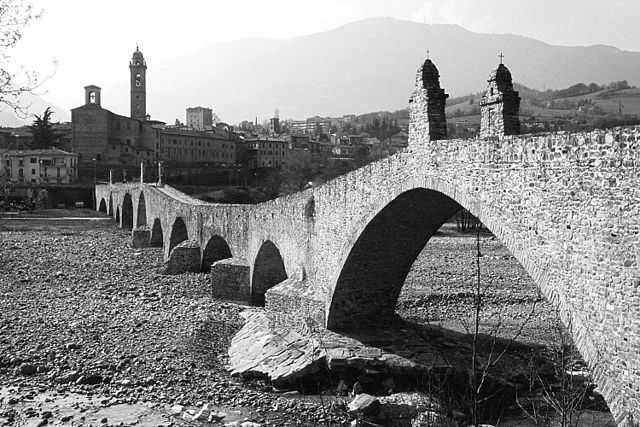 Photo: Herbert Ortner/Wikimedia Commons
Photo: Herbert Ortner/Wikimedia Commons
Ponte della Paglia, Venice
Venice's oldest stone bridge was built in 1847, and was named after the boats which moored nearby to unload their wares, including straw or 'paglia' in Italian. Sadly it's often overshadowed and used simply as a viewing point for the more spectacular Bridge of Sighs (which is only accessible from inside the Doge's Palace).
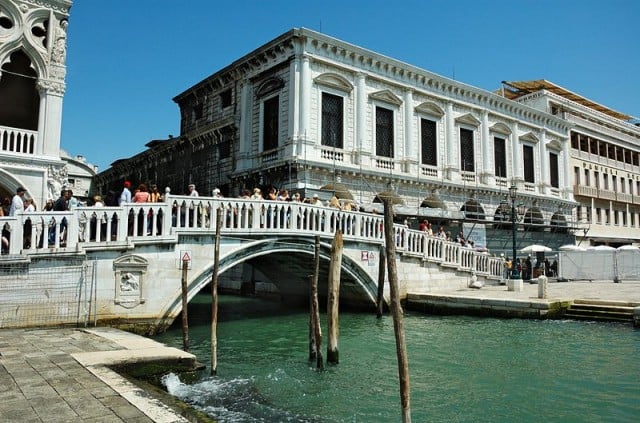 Photo: Gary Houston/Wikimedia Commons
Photo: Gary Houston/Wikimedia Commons
Ponte Coperto, Pavia
There's been a crossing point over the Ticino River here since Roman times, but the current version was built in 1949. Authorities used dynamite to destroy the previous version following a partial collapse two years earlier, due to damage from Allied bombing raids.
If you look closely, you'll see traces of the bridge from different eras, including Roman pillars (whose position gives a clue as to how the river's current used to be different) and ruined remains of the 14th-century version, which boasted ten arches and towers used for defence.
Look out for depictions of the bridge over the years in artworks on display in Pavia. And don't miss the plaque with a quote from Albert Einstein, taken from a letter to an Italian friend in which he said 'I've often thought of that beautiful bridge in Pavia'.
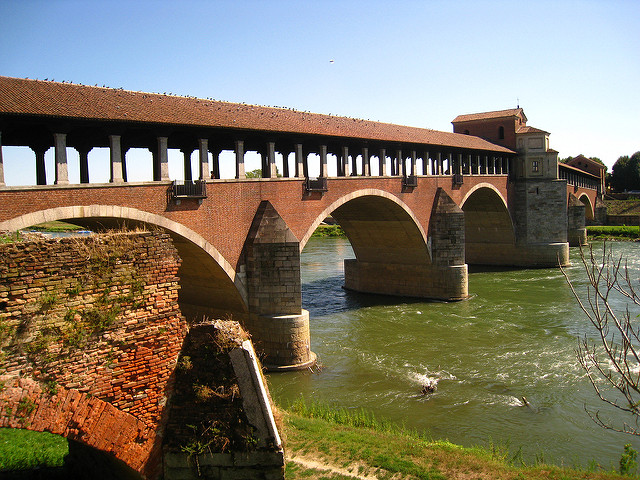 Photo: Groume/Flickr
Photo: Groume/Flickr
Ponte delle Tette
Literally translating as 'Bridge of the boobs', this one is located in what was once one of Venice's official red-light districts. Centuries ago, prostitutes were encouraged to display their breasts from the nearby balconies and windows, in an effort to stem homosexuality - which was seen as a threat - by enticing men.
These days there's far less to see there, but it will take you into a picturesque part of the city, less crowded than the tourist-filled centre.
 Didier Descouens Wiki no facebook.jpg) Photo: Didier Descouens/Wikimedia Commons
Photo: Didier Descouens/Wikimedia Commons
Ponte di Tiberio, Rimini
History fans will love this Roman bridge, built under the emperors Tiberius (hence the name) and Augustus, and finished in 20 AD. It has remained in use over the centuries, standing tall through wars, invasions, and daily footfall.
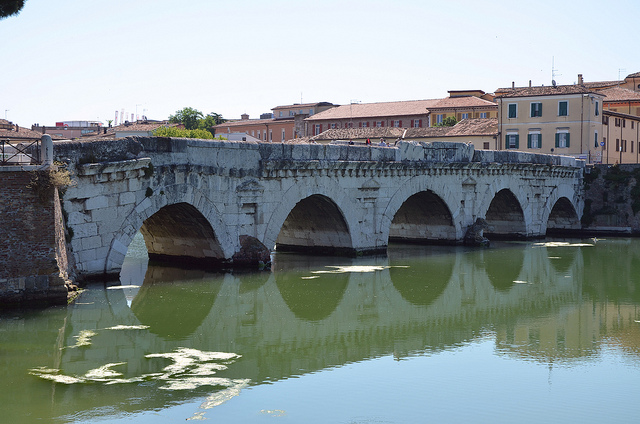 Photo: Carole Raddato/Flickr
Photo: Carole Raddato/Flickr
Ponte Nomentano, Rome.
The small tower on this bridge was once used to survey exactly who was coming in and out of the Italian capital - at the time it stood outside Rome's city boundaries, but it now lies within them. Like some of the others on this list, it's been destroyed, rebuilt and repaired over the years, and its location in the midst of a park makes for a pleasant walk.
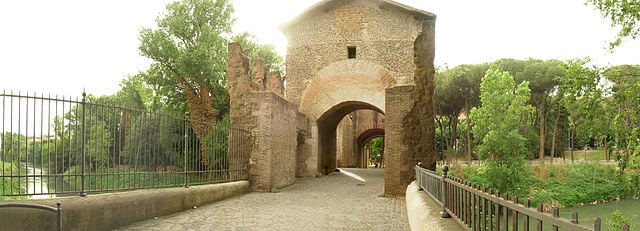
Photo: Public Domain/Wikimedia
Ponte Rialto, Venice
The oldest bridge across Venice's Grand Canal, this is the main attraction for many visitors to the city, with rows of shops on each side of the crossing. The current stone version replaced a wooden original, which was badly damaged by fire during a 14th-century revolt, then collapsed under the weight of crowds.
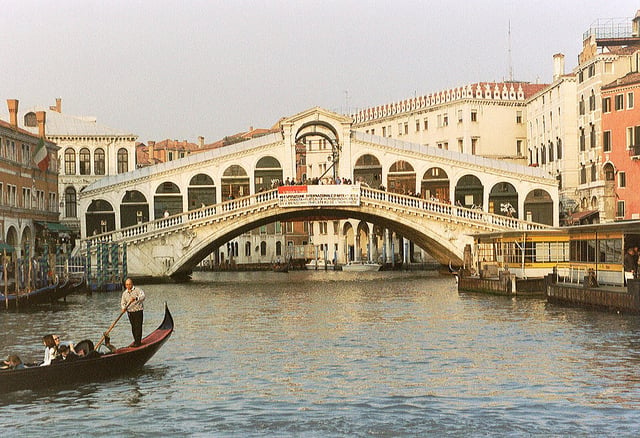
Photo: Arian Zwegers/Flickr
Pont Saint Martin, Valle d'Aosta
The bridge so nice they named the entire town after it.
The Pont-Saint-Martin has provided safe passage for almost 2000 years - and at 36 metres high, it's one of the tallest Roman bridges you'll find in Italy.
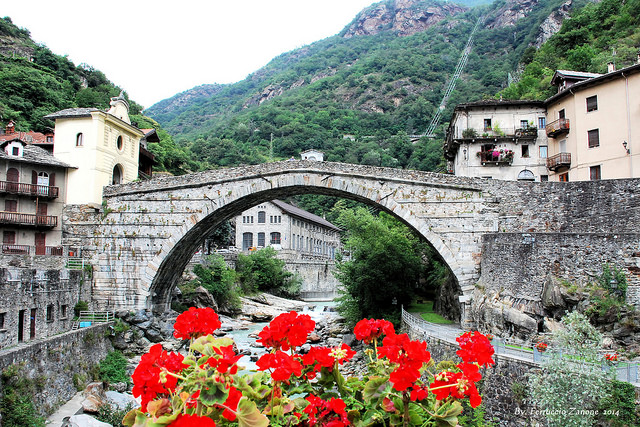
Photo: Ferrucio Zanone/Flickr
Ponte Vecchio, Florence
One of the world's best known bridges, the landmark was rebuilt in the 12th century after a flood destroyed it.
It's known for the glitzy jewellery and souvenir shops along it - centuries ago, jewellers were the only traders allowed to set up shop here because of worries over hygiene when the bridge also housed butchers and tanners.
Above the shops runs the Corridoio Vasaranio, a passageway which now houses a museum but was originally commissioned by the powerful Medici family so they could cross the river whilst avoiding mixing with ordinary Florentines.
It was the only bridge across the River Arno which wasn't destroyed by retreating German troops near the end of the Second World War. As to why it escaped the same fate, some argue that a Nazi official saved the Ponte Vecchio, and a small plaque honours him.
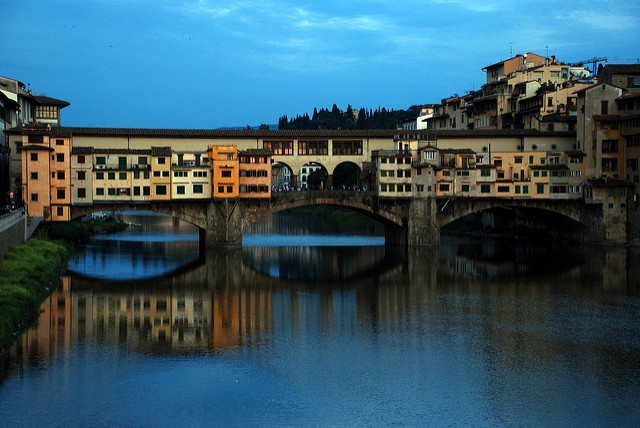
Photo: Colby Blaisdell/Flickr
Ponte Scalzi, Venice
The 'Bridge of the barefoot', as the name literally translates, is a stone arch bridge crossing Venice's Grand Canal. It takes its name from the Chiesa degli Scalzi on the north side, the seat of a Catholic order known as the Barefoot Carmelites.
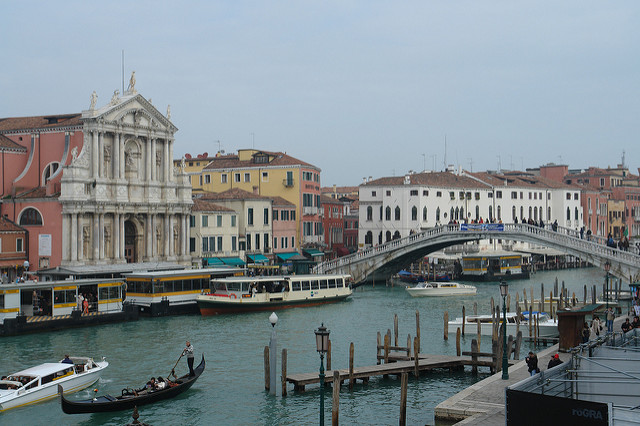
Photo: Graeme Churchard/Flickr
Tibetan Bridge, Piedmont
Finally, one for the daredevils. The Tibetan Bridge or Ponte Tibetano in Claviere is the world's longest single-span bridge. Do you dare try out the 121-metre walk?
The journey offers amazing views, both of the scenic surroundings and fossils embedded in the rock, but it will take around two hours to complete the trek.
READ ALSO: The 12 bridges you just have to cross in France
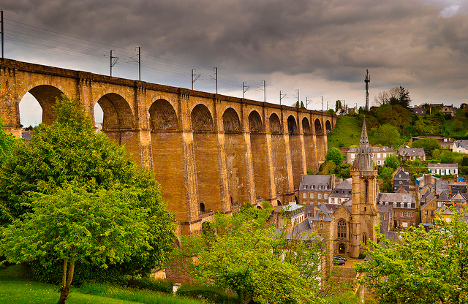
Photo: Mathieu Brient/Flickr
Comments (2)
See Also
Ponte Castelvecchio, Verona
Let's start our tour of the most beautiful Italian bridges in fair Verona, where you'll find this spectacular medieval creation. It was built by Cangrande della Scala - a 14th-century nobleman and friend of Dante - as a potential escape route when Italy was split into rival regions.
The original bridge was totally destroyed by German troops in 1945, but it has been faithfully rebuilt. Look closely and you'll see that the bridge slopes downwards towards the river's left bank, aiding a fast get-away.
 Photo: Son of Groucho/Flickr
Photo: Son of Groucho/Flickr
Ponte Sant'Angelo, Rome
Roman emperor Hadrian had this bridge built in 134 AD, linking the city centre to Castel Sant'Angelo, which now houses a museum. It's entirely pedestrianized so you can take your time strolling over it and take a close look at the statues of angels. Each of them symbolizes a part of Jesus's life and persecution.
But this bridge has a grisly past: hundreds of years ago, when the castle was a prison, bodies of executed criminals were displayed on it as a warning to Romans.
 Photo: teldridge+keldridge/Flickr
Photo: teldridge+keldridge/Flickr
Ponte Matteotti, Rome
Taking its current name from socialist politician Giacomo Matteotti, who was kidnapped nearby, this brickwork bridge was constructed in 1929.
It's gone through a series of identities, starting life as Ponte delle Milizie and then becoming Ponte Littorio, named after the symbol of Italian Fascism. After the fall of Benito Mussolini's regime, it was one of many landmarks to get a name-change. Use the bridge to cross from Rome's fancy Prati district to Flaminio.
Photo: Lalupa/Wikimedia Commons
Ponte Fabricio, Rome
Spanning half of the Tiber River, this is Rome's oldest bridge still to exist in its original state, dating back to 62 BC. Astonishingly, it has remained in consistent use, so you can walk all 62 metres of it today.
 Photo: Ann Baekken/Flickr
Photo: Ann Baekken/Flickr
Ponte della Costituzione, Venice
Of course it wouldn't be an article about bridges without several mentions of Italy's canal-lined city, starting with this modern construction which has been in place less than a decade. It's also known as the Calatrava bridge, a nod to its designer Sergio Calatrava, but it's become pretty controversial.
Some complained that the Grand Canal didn't need a fourth bridge, while others felt that the minimalist style didn't match with the rest of the city. Then there were practical concerns, such as lack of wheelchair access.
 Photo: Michelino Calenda/Flickr
Photo: Michelino Calenda/Flickr
Ponte Gobbo, Piacenza
Literally translating as 'the Hunchbacked Bridge', this landmark is also known as Ponte Vecchio or Ponte del Diavolo, the Devil's Bridge. 273 metres long, it gets its official name from the 11 irregular arches that make it up.
But what's the devil got to do with it? Well, in the Middle Ages, building a bridge was a difficult task, and some thought that if God had chosen to keep two towns separate, then joining them artificially was doing 'the devil's work'.
Several legends surround the bridge, one claiming that the devil promised Saint Colombano he would build a bridge in exchange for the soul of the first living creature to cross it. The devil was assisted by a group of demons of various shapes and sizes - hence the hunchbacked nature of the bridge - but then, the saint sent over a small dog rather than a person, tricking the devil.
 Photo: Herbert Ortner/Wikimedia Commons
Photo: Herbert Ortner/Wikimedia Commons
Ponte della Paglia, Venice
Venice's oldest stone bridge was built in 1847, and was named after the boats which moored nearby to unload their wares, including straw or 'paglia' in Italian. Sadly it's often overshadowed and used simply as a viewing point for the more spectacular Bridge of Sighs (which is only accessible from inside the Doge's Palace).
 Photo: Gary Houston/Wikimedia Commons
Photo: Gary Houston/Wikimedia Commons
Ponte Coperto, Pavia
There's been a crossing point over the Ticino River here since Roman times, but the current version was built in 1949. Authorities used dynamite to destroy the previous version following a partial collapse two years earlier, due to damage from Allied bombing raids.
If you look closely, you'll see traces of the bridge from different eras, including Roman pillars (whose position gives a clue as to how the river's current used to be different) and ruined remains of the 14th-century version, which boasted ten arches and towers used for defence.
Look out for depictions of the bridge over the years in artworks on display in Pavia. And don't miss the plaque with a quote from Albert Einstein, taken from a letter to an Italian friend in which he said 'I've often thought of that beautiful bridge in Pavia'.
 Photo: Groume/Flickr
Photo: Groume/Flickr
Ponte delle Tette
Literally translating as 'Bridge of the boobs', this one is located in what was once one of Venice's official red-light districts. Centuries ago, prostitutes were encouraged to display their breasts from the nearby balconies and windows, in an effort to stem homosexuality - which was seen as a threat - by enticing men.
These days there's far less to see there, but it will take you into a picturesque part of the city, less crowded than the tourist-filled centre.
 Didier Descouens Wiki no facebook.jpg) Photo: Didier Descouens/Wikimedia Commons
Photo: Didier Descouens/Wikimedia Commons
Ponte di Tiberio, Rimini
History fans will love this Roman bridge, built under the emperors Tiberius (hence the name) and Augustus, and finished in 20 AD. It has remained in use over the centuries, standing tall through wars, invasions, and daily footfall.
 Photo: Carole Raddato/Flickr
Photo: Carole Raddato/Flickr
Ponte Nomentano, Rome.
The small tower on this bridge was once used to survey exactly who was coming in and out of the Italian capital - at the time it stood outside Rome's city boundaries, but it now lies within them. Like some of the others on this list, it's been destroyed, rebuilt and repaired over the years, and its location in the midst of a park makes for a pleasant walk.

Photo: Public Domain/Wikimedia
Ponte Rialto, Venice
The oldest bridge across Venice's Grand Canal, this is the main attraction for many visitors to the city, with rows of shops on each side of the crossing. The current stone version replaced a wooden original, which was badly damaged by fire during a 14th-century revolt, then collapsed under the weight of crowds.

Photo: Arian Zwegers/Flickr
Pont Saint Martin, Valle d'Aosta
The bridge so nice they named the entire town after it.
The Pont-Saint-Martin has provided safe passage for almost 2000 years - and at 36 metres high, it's one of the tallest Roman bridges you'll find in Italy.

Photo: Ferrucio Zanone/Flickr
Ponte Vecchio, Florence
One of the world's best known bridges, the landmark was rebuilt in the 12th century after a flood destroyed it.
It's known for the glitzy jewellery and souvenir shops along it - centuries ago, jewellers were the only traders allowed to set up shop here because of worries over hygiene when the bridge also housed butchers and tanners.
Above the shops runs the Corridoio Vasaranio, a passageway which now houses a museum but was originally commissioned by the powerful Medici family so they could cross the river whilst avoiding mixing with ordinary Florentines.
It was the only bridge across the River Arno which wasn't destroyed by retreating German troops near the end of the Second World War. As to why it escaped the same fate, some argue that a Nazi official saved the Ponte Vecchio, and a small plaque honours him.

Photo: Colby Blaisdell/Flickr
Ponte Scalzi, Venice
The 'Bridge of the barefoot', as the name literally translates, is a stone arch bridge crossing Venice's Grand Canal. It takes its name from the Chiesa degli Scalzi on the north side, the seat of a Catholic order known as the Barefoot Carmelites.

Photo: Graeme Churchard/Flickr
Tibetan Bridge, Piedmont
Finally, one for the daredevils. The Tibetan Bridge or Ponte Tibetano in Claviere is the world's longest single-span bridge. Do you dare try out the 121-metre walk?
The journey offers amazing views, both of the scenic surroundings and fossils embedded in the rock, but it will take around two hours to complete the trek.
READ ALSO: The 12 bridges you just have to cross in France

Photo: Mathieu Brient/Flickr
Join the conversation in our comments section below. Share your own views and experience and if you have a question or suggestion for our journalists then email us at [email protected].
Please keep comments civil, constructive and on topic – and make sure to read our terms of use before getting involved.
Please log in here to leave a comment.